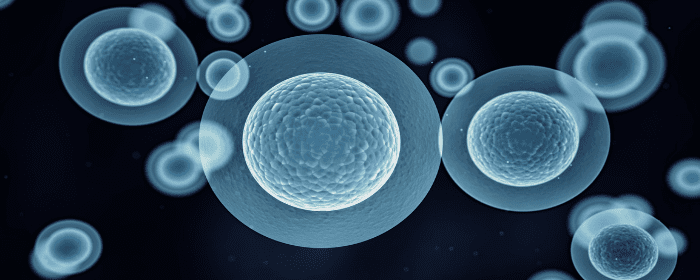
by Stemedix | Oct 11, 2021 | Mesenchymal Stem Cells, Stem Cell Therapy
Over the last decade, the field of stem cell therapy has grown in research and awareness. This growth is thanks to mesenchymal stem cells (MSCs,) the type of cells most commonly explored for their powerful reparative properties. Medical professionals can harvest and concentrate these MSCs from multiple sources, making them more accessible. As a result, stem cells can be used as a form of regenerative medicine. This intervention offers potential benefits for patients suffering from neurodegenerative, orthopedic, and autoimmune conditions. This article will outline some basic information about MSCs and how Mesenchymal stem cells repair.
Basic Biology of MSCs
Stem cells are a unique type of cell. Unlike other cells, MSCs can divide into daughter cells and then transform into specialized cells such as those found in bone, brain matter, and soft tissue. Stem cells can be divided into two broad categories, embryonic and adult stem cells.
Adult stem cells are the primary type used in modern medical interventions. When adult stem cells were initially discovered, scientists believed they were only present in the bone marrow.
While bone marrow aspirate can be an ideal source of stem cells, they are also present in adipose tissue, dental pulp, the kidneys, amniotic fluid, and the amniotic membrane. However, they are primarily harvested from adipose tissue, bone marrow, or umbilical cords.
MSCs’ Reparative Properties
Stem cells are naturally present in the human body. However, the concentration of these valuable cells is reduced as people age. As a result, older individuals typically have longer recovery times from injuries and are more prone to degenerative conditions.
Mesenchymal stem cells allow medical professionals to circumvent this natural degradation. They can harvest stem cells, concentrate them, and then administer them to a specific location, such as the site of an injury. Once administered, the stem cells will seek out inflammation and repair damaged tissue, thereby accelerating the natural healing process.
The Harvesting Process
Before they can be administered, stem cells must be harvested. Many patients opt for autologous stem cell therapy. This treatment involves the concentration of stem cells derived from the patient’s existing body tissues.
When preparing to harvest stem cells, the provider usually administers a local anesthetic. The provider will then harvest either bone marrow aspirate or adipose (fat) tissue depending on the preference and treatment plan. The stem cells are processed, concentrated, and administered back to the patient to targeted areas.
Stem cells have the potential to supplement the patient’s healing capabilities for six months to a year. This intervention can be utilized to treat many different conditions and may offer patients an alternative to traditional options or in conjunction with. If you would like to learn more about how Mesenchymal Stem Cells repair, contact us today!

by admin | Oct 8, 2021 | Stem Cell Therapy, Exosomes, Parkinson's Disease, Stem Cell Research
Parkinson’s disease (PD) is a debilitating neurodegenerative disorder that currently affects nearly 6 million people worldwide and is currently the second most common neurological condition, behind only Alzheimer’s.
Although the exact cause of PD remains unclear, the condition is characterized by the gradual loss of nerve cells in the brain responsible for producing the neurotransmitter dopamine[1]. While no cure for PD currently exists, current therapeutic treatment approaches focus on improving quality of life but are not able to prevent or slow the progression of the disease.
Recent research has demonstrated positive effects of mesenchymal stem cell (MSC) transplantation that has been associated with secromes; noted beneficial effects include providing a self-regulated regenerative response that limits the area of lesions. Additionally, these MSC-derived secretomes compose soluble factors and encapsulated extravesicles (EV). These EVs have been found to have a significant impact on physiological processes, including cell-to-cell communication.
Considering MSCs are readily available and easily isolated from a number of sources, including adipose tissue, umbilical cord Wharton’s Jelly, bone marrow, and dental pulp, these stem cells are thought to hold potential as a therapeutic approach to managing PD.
As part of this review, d’Angelo et al. highlight a number of studies demonstrating the potential of MSCs in improving a number of conditions and symptoms consistent with those demonstrated in PD. In these studies, animal models demonstrate improved motor behaviors and correction of functional impairment after transplantation of MSCs.
The authors point out that further research exploring cell-free, therapeutic, personalized approaches for the different neurodegenerative diseases, including PD, is needed.
d’Angelo et al. also note that, while MSC-derived secretomes have shown positive effects on neuronal cell survival, differentiation, and proliferation, further studies are needed to fully understand all of the bioactive molecules.
Since MSC-derived secretomes are able to stimulate neurotrophic and neuronal survival pathways and appear to counteract neuronal death, they could potentially be a beneficial tool in future management and prevention efforts for a number of neurodegenerative conditions, including Parkinson’s disease, Alzheimer’s disease, and stroke.
Source:(2020, July 23). Insights into the Effects of Mesenchymal Stem Cell-Derived … – NCBI. Retrieved from https://www.ncbi.nlm.nih.gov/pmc/articles/PMC7432166/
[1] “Parkinsonfoundation.org -.” https://parkinsonfoundation.org/. Accessed 5 Oct. 2021.

by Stemedix | Oct 4, 2021 | Stem Cell Therapy
Whether you’re suffering from a neurodegenerative condition like ALS or are recovering from a sports or athletic injury, regenerative medicine, also known as stem cell therapy, offers a host of potential benefits for treating your condition. However, one of the most common questions we hear is when patients should seek to start stem cell therapy treatments. Of course, there’s no single, simple answer, since each patient’s case is unique. However, in general, results may be most optimal soon after newly diagnosed conditions. This does not mean results may not be beneficial if the condition or injury has been endured for a longer period.
Is There a Time Consideration When to Have?
Stem cell treatments have a greater potential to help provide relief if the injury is relatively minor or if the condition is a newer diagnosis. For many conditions, that means seeking treatment early in the progression stage. If it is later, more subsequent therapies may be a potential need to help manage symptoms or the condition further.
Still, no matter how long you’ve been dealing with your condition, stem cells hold a potential alternative option to provide a management tool for some degree of improvement or stabilization. When it comes to stem cell therapy, it helps to think less in terms of shortening the problem and more in terms of how there is potential to help reduce the severity.
Treating Orthopedic Conditions
One of the most common reasons patients seek stem cell therapy is to help recover from a musculoskeletal injury. These injuries often cause pain in joints like the knee and the hip. By introducing stem cells into the affected area, it has the ability to stimulate regenerative and healing properties, which can help to lessen the severity of the injury.
When dealing with newly diagnosed conditions, it is important to allow time for the treatment to have its course of healing potential on the injury and body. It is important to also follow post-management care for the most optimal outcomes.
Considerations for Post-Treatment
Depending on your condition, you may need to avoid strenuous exercise or overuse of a joint or muscle for a period of time. However, many times you can simply return to everyday life, as long as you take care not to aggravate the area.
It’s a good idea to block out a day for your treatment and plan for a short recovery period if an active lifestyle is a normal part of your day-to-day. You may experience some mild soreness, but in many cases, you will be able to resume your everyday life with careful healing instructions. If you would like to schedule a consultation contact a care coordinator today!

by admin | Oct 1, 2021 | Stem Cell Therapy, Osteoarthritis, PRP, Stem Cell Research
With nearly 30 million people in the US affected by osteoarthritis (OA), the condition continues to be among the leading causes of chronic pain and disability. Considering that advances in medical technology have increased overall life expectancy, the number of people living longer and dealing with the effects of OA is expected to increase for the foreseeable future.
Although modern medicine has improved the way most diseases and chronic conditions are diagnosed and treated, OA treatment has not benefited from these advances. As a result, treatment and prevention of OA continue to focus primarily on controlling and minimizing symptoms associated with the condition, not treating or preventing the condition itself. Unfortunately, for many, when symptoms of OA progress to a point where the pain is no longer able to be managed, their options look to surgical replacement of the affected joint.
While there are many contributing factors related to the onset and progression of OA, including obesity, history of trauma, genetics, and heritable and acquired disorders, there also appears to be an association between the onset of OA and a depleted local population of mesenchymal stem cells (MSCs).
Considering the apparent relationship between OA and MSCs, Freitag et al. reviewed the reparative pathways, safety, and efficacy of MSC therapy in the treatment of osteoarthritis.
With their ease of harvest and ability to expand into chondrocytes, MSCs have continued to gain interest when exploring various stem cell therapies for the active management of pain and symptoms associated with OA.
Freitag et al. found that preclinical and clinical results of studies of cartilage repair techniques that utilize MSCs, including MSC scaffold transplantation techniques, MSC injectable techniques, MSC as a vehicle for platelet-rich plasma (PRP), and hyaluronic acid (HA) as an active carrier of MSCs, have all shown favorable results in supporting the benefits of MSC for the improvement of function and regeneration of new tissue in those afflicted with OA.
With over 400 active trials currently examining the efficacy of MSCs in the treatment of a variety of conditions, including OA, the safety of utilizing MSC therapy continues to draw interest from the medical community.
Although some early studies appeared to raise the question of abnormal cell growth, and ultimately the safety, associated with MSC therapy, the authors’ systematic review of clinical trials found that, while caution needs to be undertaken when culturing MSCs, the evidence demonstrates MSCs are generally safe for therapeutic use for the treatment of OA.
Freitag et al. conclude that the rapid progression of OA and related conditions demonstrate the need for therapies that repair and prevent these diseases, not just manage pain and related symptoms. As such, the authors feel MSC therapy offers a safe and viable option for the eventual treatment and prevention of OA and calls for further randomized controlled trials to evaluate the most effective applications of MSCs for managing osteoarthritis.
Source: (2016, May 26). Mesenchymal stem cell therapy in the treatment of osteoarthritis. Retrieved from https://bmcmusculoskeletdisord.biomedcentral.com/articles/10.1186/s12891-016-1085-9

by Stemedix | Sep 27, 2021 | Pain Management, Stem Cell Therapy
Joint arthritis is a very common condition that causes pain. According to some research, nearly half of adults over 65 suffer from arthritis of the joints. Aging causes wear and tear to the cartilage that protects the joints. While there is no way to fully prevent this wear and tear, innovative technologies are available to manage joint arthritis pain.
Some patients have found potential alternative options to help manage pain and inflammation with regenerative medicine, also known as stem cell therapy. Below, we will discuss the potential benefits of stem cell treatments for joint arthritis pain.
Why Does Joint Arthritis Happen?
When the cartilage in a joint begins to break down, the associated bones may rub together. This can be incredibly painful. It can also lead to swelling, stiffness, and decreased range of motion for a patient.
There are several different types of joint arthritis. One of the most common types is osteoarthritis. This is also known as “degenerative” arthritis. Degenerative arthritis is often the result of using a particular joint for many years. It usually appears when patients are middle-aged and progresses as they get older. But younger people are susceptible to this condition, as well.
Joint pain can also result from a condition called Rheumatoid Arthritis. This is an autoimmune disease that can lead to inflammation and pain. Infection and gout can also account for ongoing joint pain.
Common Symptoms
Usually, arthritis will cause aching or throbbing around a single location. The following joints are some of the more common areas affected: hips, shoulders, wrists, knees, hands, and feet.
In some cases of joint arthritis, the pain can be spread throughout the body along with pain concentrated around damaged joints.
No matter what the underlying cause of their joint pain is, many patients are exploring stem cell therapy to help manage their symptoms and improve their quality of life.
Stem Cell Therapies for Joint Pain
Stem cells are a type of simple human cell. As such, they are present in the human body naturally. These simple cells act as an instructional system for repairing and healing certain bodily tissues. Stem cell treatments involve isolating and reintroducing these reparative cells into damaged areas of the body.
Our natural stem cells may not be enough to help with joint arthritis and for this reason, stem cell therapy provides a concentrated amount of mesenchymal stem cells to be administered systemically and to problematic areas.
Many patients have reported pain and inflammation relief as well as tissue repair outcomes through these innovative and minimally invasive stem cell therapies. If you would like to learn more contact us today!

by Stemedix | Sep 20, 2021 | ALS, Stem Cell Therapy
Standard treatment protocols for Amyotrophic Lateral Sclerosis (ALS) are typically focused on educating and managing the severity of symptoms they may be facing. However, stem cell-based therapy is an alternative option for managing this condition and its symptoms. This optional therapy has been the subject of several studies in recent years and the initial results have shown positive outcomes. Here we will talk about Stem cell therapy for Amyotrophic Lateral Sclerosis.
Regenerative medicine, also known as stem cell therapy, involves the administration of a concentrated volume of stem cells to targeted areas. It is a management tool to potentially slow down the progression of ALS as well as help to manage symptoms or the development of new symptoms.
Stem cells are naturally present in the body. Mesenchymal stem cells are the most commonly used in cell-based therapies. They can be derived from autologous (Adipose or Bone Marrow) and allogeneic tissues (Wharton’s Jelly). Studies have shown these to be safe and potentially effective for their regenerative and therapeutic properties.
Below, we’ll examine the potential benefits of cell-based therapies for ALS.
The Condition
Often referred to as Lou Gehrig’s disease, Amyotrophic Lateral Sclerosis is a neurodegenerative condition that is characterized by a progressive breakdown in motor skills and voluntary control of movements. The condition can progress quickly or slowly over time.
Some of the most common symptoms of ALS include:
- Difficulty walking
- Frequent falling and tripping
- Weakness in the hands
- Slurred speech
- Muscle cramps
- Inappropriate laughing or crying
- Behavioral and cognitive changes
Potential Application of Stem Cells for Managing ALS
Currently, the potential benefits of stem cell therapy for ALS are still being researched and studied. With that being said, early data is has shown to be promising.
Patients who have had little success with conventional protocols or may want to add to their current therapies have been exploring stem cell therapy to potentially slow the progression of the disease and help manage symptoms. Mesenchymal stem cells help stimulate the body’s natural healing capabilities and have the ability to regenerate damaged tissues.
A clinical trial showed results that support that stem cells could potentially reduce functional impairments. Patients in the trial experienced no significant side effects and the procedure was tolerated well by all of the trial participants.
Stem cells are safe for repetitive use, as well, which means that patients can receive ongoing maintenance treatments if the therapy provides positive results even if this result is slowing down or stabilizing the progression of the condition.
The hope is that there will soon be additional, large-scale randomized control trials on stem cell therapies for ALS in the future. These types of trials would provide further insights into the potential of this treatment option for ALS patients.
Fortunately, access to stem cell therapy for Amyotrophic Lateral Sclerosis ( ALS ) is currently available, which gives patients additional therapy options when exploring how to help manage their condition and symptoms.







 St. Petersburg, Florida
St. Petersburg, Florida
